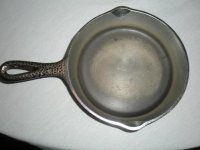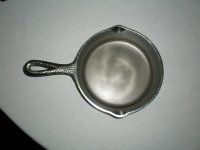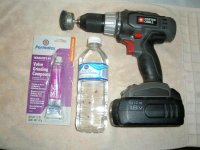Wasn't quiet sure where to post this thread so here goes. Most of us including myself have nickel plated skillets that have worn surfaces that are splotchy and unattractive to the eye. I have been pondering on how to simply remove the remainder of nickel plating from the cooking surface without any damage to that surface and retain the cast iron effect that we are familiar with on regular skillets. I did a trial run this evening on a #3 Lodge hammered and nickel plated that turned out great. I used valve grinding compound and a cupped stainless steel brush and electric drill. With less than 5 min. and constant pressure and drill on high speed all nickel plating was removed with no marks visible to the surface. I used Perma-Tex Valve Grinding Compound from the auto store and several drops of water to make a good slurry. I do not in any way want to suggest that this is an absolute way to remove nickel plating to the outside of a skillet but it sure did the job on the inside for me. There was no residual iron from this process and it washed up clean with soap and water. Attached is two pic's "before and after" for your viewing pleasure.
-
If a web search for the answer to your cast iron cookware question has brought you directly to this forum, the information you seek may be covered in one of the many reference topics featured on the main website.
Quick Links: · Main Website · How to Identify Unmarked Pans · All About Cleaning & Seasoning · Reproductions & Counterfeits · Commonly-Used Terms
You are using an out of date browser. It may not display this or other websites correctly.
You should upgrade or use an alternative browser.
You should upgrade or use an alternative browser.
Nickel Plating
- Thread starter MDFraley
- Start date
Firm bristles and 2" dia. Depending on the size skillet may determine how big the cup brush you want to use. I have more #3's than anything so my experiment started there. I have a #5 & #6 Griswold that are in my sights next and I may graduate to a larger brush for those. I did my first season to it last night and it darkened up quiet nicely. I want to do several more seasoning's and may do a re-post with a pic.
If it is not too much trouble, how about a pic of the tools that you used.
Here is a pic of your request.....Nothing rocket science about them. Keeping the compound as a slurry seems to be the secret to better removal. That is where the water comes into play. The slurry and drill speed will throw out some bits as you proceed so be prepared for this and do it in an area that may be designated for messy cleaning.
Attachments
I want to add one more bit of info to this thread and then I'll shut up.....With any product on the market manufacture's will protect themselves with cautions and the Permatex is not different. I can't imagine anyone eating spoonful's of this product and like any other cleaning process's we use a final soap and water cleaning should remove any traces of the solution thus making our skillets safe to cook in afterwards.
And you're sure the nickel is totally gone? Not just polished to the same color and texture as the iron? This is fantastic wisdom, thanks for sharing!
Hard question to answer especially since I have no means of testing the metal. My piece was completely cleaned of the nickel leaving the surface appearance of a piece cleaned by electrolysis.
I will quote what's on the back of the Permatex package. " Valve grinding compound aids grinding and seating operations by removing burrs, surface defects, carbon, gum and corrosion. It mixes with water to form an easy to use paste that can be used for grinding chromium."
After this was linked in a recent post and I read it, I'm bumping the thread because I have a question:
Did you try using the cup brush without the compound first? Wondering about how much of a difference the compound made.
Nice work.
Eric,
You can always use the personal message for contact regarding specific's of a process. I'm sure DougD cringes when he see's old threads being re-hashed.
To answer your question; The metal to metal creates friction and will end up polishing the work more than removal. The valve grinding compound serves as a buffer and mixed correctly with the right amount of water removed the plating as I thought it would. My dad used the compound when he over-hauled car engines on re-seating valves. Those old engines were cast iron blocks and heads that were machined thus my experiment was based on theory alone.
It may or may not be of any use for what you all are trying to achieve.



